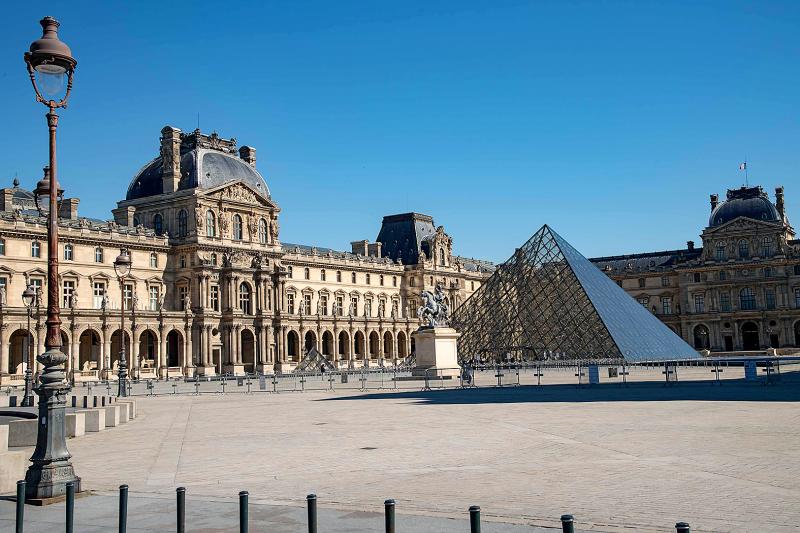Stories behind art treasures such as Delacroix’s The Death of Sardanapalus in the Louvre and a 19th-century relief of Phaeton driving the Chariot of the Sun at the Royal Academy of Arts are to made free for the rest of the year by the world’s most downloaded museum app.
Smartify is often known as the “Shazam for art” app in that it allows people to identify works of art by simply scanning them on a smartphone. It has about 2 million artworks from more than 120 venues.
It also has audio and visual museum tours which are a mix of paid and free depending on the museum or exhibition.

Photo: AFP
Because no one will be seeing the Mona Lisa in Paris or the Laughing Cavalier at the Wallace Collection in London any time soon, Smartify said it would make all its audio tours free for the rest of the year.
Exhibitions that were due to open, but have been closed because of coronavirus, will also be launched on the app as audio and visual tours.
The Smartify app was founded in the UK as a social enterprise by four friends in 2017. Anna Lowe, one of the co-founders, said the mission had always been about supporting museums and increasing access to art.
“We started with around 30 museums, predominantly in the UK, and now we’re global with 2 million artworks and we are the world’s most downloaded museum app.”
The job now was to help make sure museum collections were as accessible as possible, she said.
“Obviously we have seen a change in the way the app is used,” she said. “We started the app from a love of visiting museums and galleries and seeing and connecting with art. At times like this, really strange times, people look to art and music and culture for inspiration, solace a sense of normal.”
Many galleries are now adding tours for exhibitions that have closed.
They include the Watts Gallery-Artists’ Village in Surrey, which closed one week into its new exhibition exploring the art critic John Ruskin.
The Museum of London is soon to add an audio tour of its Clash: London Calling display. All the objects in the show are already listed on the app.
The Lowry in Salford and Waddesdon Manor in Buckinghamshire are also working on new tours that will be added soon.
Among the audio and visual tours now free to listen is one by Mary Beard, a mythology trail through the RA’s collection, and a masterpieces of the Louvre tour which takes people from the Great Sphinx of Tanis to Leonardo da Vinci’s Mona Lisa and The Virgin of the Rocks.

In the March 9 edition of the Taipei Times a piece by Ninon Godefroy ran with the headine “The quiet, gentle rhythm of Taiwan.” It started with the line “Taiwan is a small, humble place. There is no Eiffel Tower, no pyramids — no singular attraction that draws the world’s attention.” I laughed out loud at that. This was out of no disrespect for the author or the piece, which made some interesting analogies and good points about how both Din Tai Fung’s and Taiwan Semiconductor Manufacturing Co’s (TSMC, 台積電) meticulous attention to detail and quality are not quite up to

April 21 to April 27 Hsieh Er’s (謝娥) political fortunes were rising fast after she got out of jail and joined the Chinese Nationalist Party (KMT) in December 1945. Not only did she hold key positions in various committees, she was elected the only woman on the Taipei City Council and headed to Nanjing in 1946 as the sole Taiwanese female representative to the National Constituent Assembly. With the support of first lady Soong May-ling (宋美齡), she started the Taipei Women’s Association and Taiwan Provincial Women’s Association, where she

Chinese Nationalist Party (KMT) Chairman Eric Chu (朱立倫) hatched a bold plan to charge forward and seize the initiative when he held a protest in front of the Taipei City Prosecutors’ Office. Though risky, because illegal, its success would help tackle at least six problems facing both himself and the KMT. What he did not see coming was Taipei Mayor Chiang Wan-an (將萬安) tripping him up out of the gate. In spite of Chu being the most consequential and successful KMT chairman since the early 2010s — arguably saving the party from financial ruin and restoring its electoral viability —

It is one of the more remarkable facts of Taiwan history that it was never occupied or claimed by any of the numerous kingdoms of southern China — Han or otherwise — that lay just across the water from it. None of their brilliant ministers ever discovered that Taiwan was a “core interest” of the state whose annexation was “inevitable.” As Paul Kua notes in an excellent monograph laying out how the Portuguese gave Taiwan the name “Formosa,” the first Europeans to express an interest in occupying Taiwan were the Spanish. Tonio Andrade in his seminal work, How Taiwan Became Chinese,